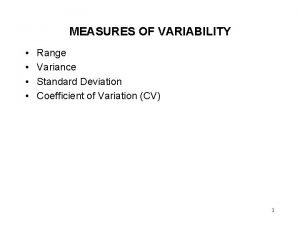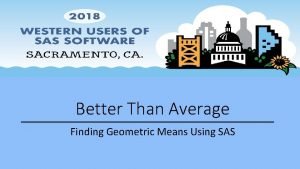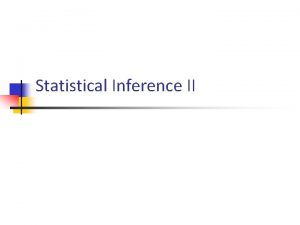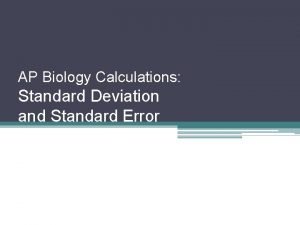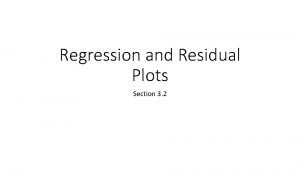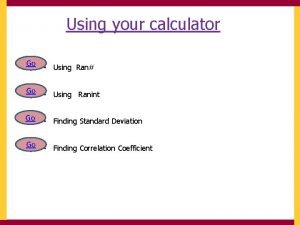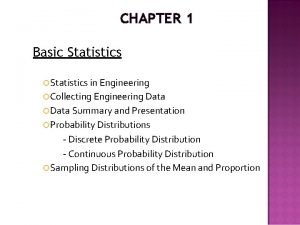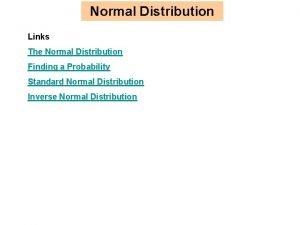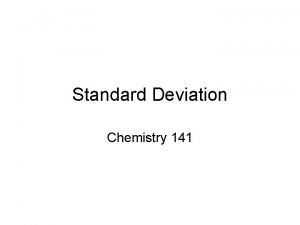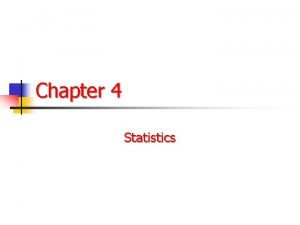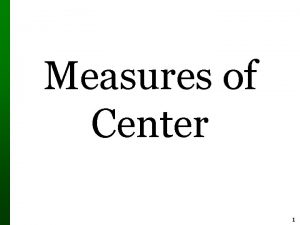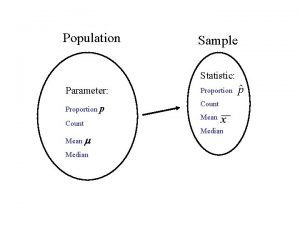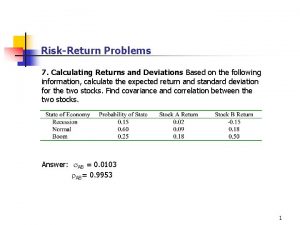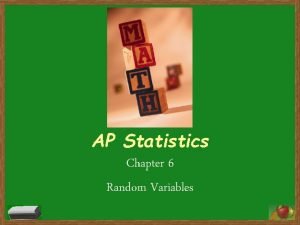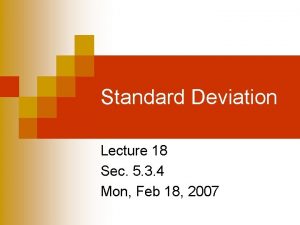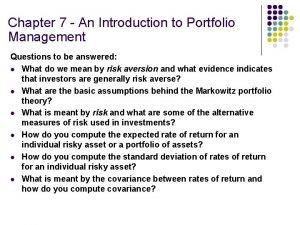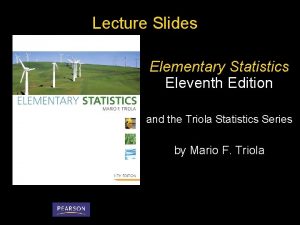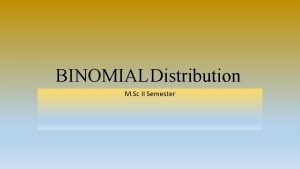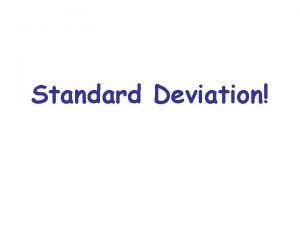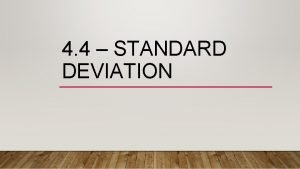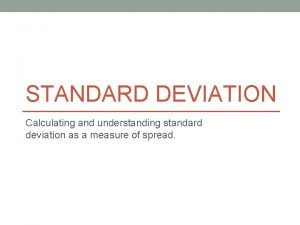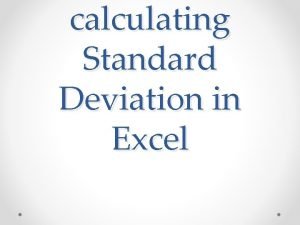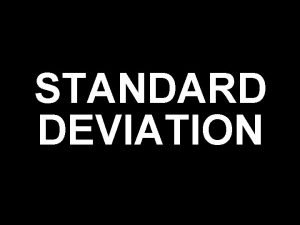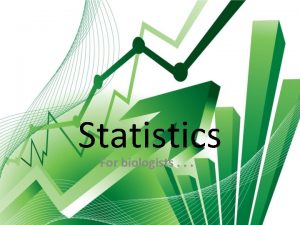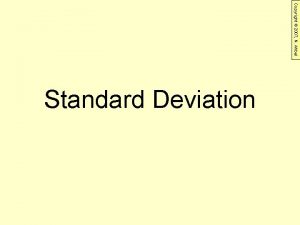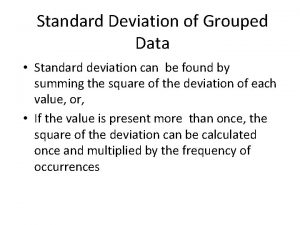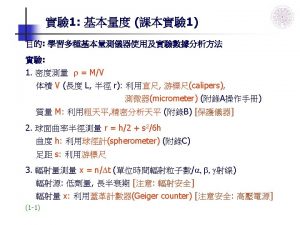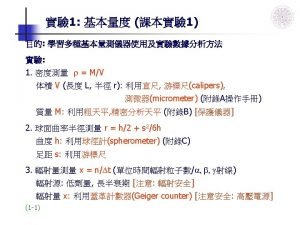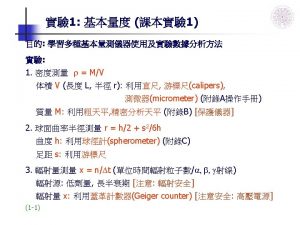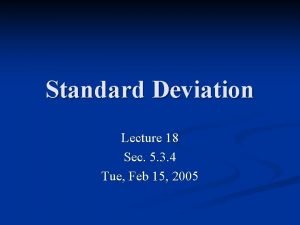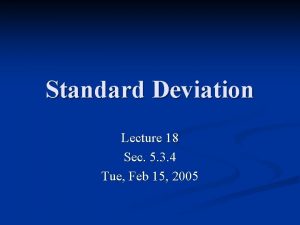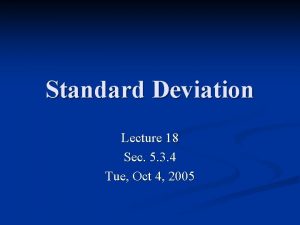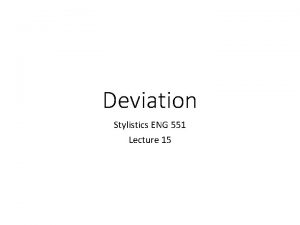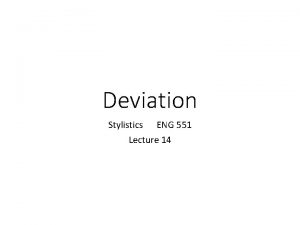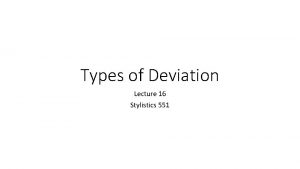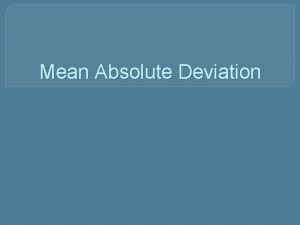Standard Deviation Lecture 18 Sec 5 3 4
































- Slides: 32

Standard Deviation Lecture 18 Sec. 5. 3. 4 Mon, Feb 18, 2007

Variability Our ability to estimate a parameter accurately depends on the variability of the population. n What do we mean by variability in the population? n How do we measure it? n

Deviations from the Mean Each unit of a sample or population deviates from the mean by a certain amount. n Define the deviation of x to be (x – x). n 1 2 3 4 5 6 7 8 9 10

Deviations from the Mean Each unit of a sample or population deviates from the mean by a certain amount. n Define the deviation of x to be (x – x). n 1 2 3 4 5 x = 6 6 7 8 9 10

Deviations from the Mean n Each unit of a sample or population deviates from the mean by a certain amount. deviation = – 5 1 2 3 4 5 x = 4 6 7 8 9 10

Deviations from the Mean n Each unit of a sample or population deviates from the mean by a certain amount. dev = – 2 1 2 3 4 5 x = 4 6 7 8 9 10

Deviations from the Mean n Each unit of a sample or population deviates from the mean by a certain amount. dev = +1 1 2 3 4 5 x = 4 6 7 8 9 10

Deviations from the Mean n Each unit of a sample or population deviates from the mean by a certain amount. dev = +2 1 2 3 4 5 x = 4 6 7 8 9 10

Deviations from the Mean n Each unit of a sample or population deviates from the mean by a certain amount. deviation = +4 1 2 3 4 5 x = 4 6 7 8 9 10

Deviations from the Mean How do we obtain one number that is representative of the whole set of individual deviations? n Normally we use an average to summarize a set of numbers. n Why will the average not work in this case? n

Sum of Squared Deviations We will square them all first. That way, there will be no canceling. n So we compute the sum of the squared deviations, called SSX. n

Sum of Squared Deviations n Procedure ¨ Find the average ¨ Find the deviations from the average ¨ Square the deviations ¨ Add them up

Sum of Squared Deviations n SSX = sum of squared deviations n For example, if the sample is {1, 4, 7, 8, 10}, then SSX = (1 – 6)2 + (4 – 6)2 + (7 – 6)2 + (8 – 6)2 + (10 – 6)2 = (– 5)2 + (– 2)2 + (1)2 + (2)2 + (4)2 = 25 + 4 + 16 = 50.

The Population Variance of the population n The population variance is denoted by 2.

The Population Standard Deviation n The population standard deviation is the square root of the population variance.

The Sample Variance n Variance of a sample n The sample variance is denoted by s 2.

The Sample Variance n Theory shows that if we divide by n – 1 instead of n, we get a better estimator of 2. n Therefore, we do it.

Example In the example, SSX = 50. n Therefore, s 2 = 50/4 = 12. 5. n

The Sample Standard Deviation n The sample standard deviation is the square root of the sample variance. n We will interpret this as being representative of deviations in the sample.

Example In our example, we found that s 2 = 12. 5. n Therefore, s = 12. 5 = 3. 536. n How does that compare to the individual deviations? n

Alternate Formula for the Standard Deviation n An alternate way to compute SSX is to compute n Then, as before

Example n n n Let the sample be {1, 4, 7, 8, 10}. Then x = 30 and x 2 = 1 + 16 + 49 + 64 + 100 = 230. So SSX = 230 – (30)2/5 = 230 – 180 = 50, as before.

TI-83 – Standard Deviations n n Follow the procedure for computing the mean. The display shows Sx and x. ¨ Sx is the sample standard deviation. ¨ x is the population standard deviation. n Using the data of the previous example, we have ¨ Sx = 3. 535533906. ¨ x = 3. 16227766.

Interpreting the Standard Deviation The standard deviation is directly comparable to actual deviations. n How does 3. 536 compare to -5, -2, +1, +2, and +4? n

Interpreting the Standard Deviation Observations that deviate from x by much more than s are unusually far from the mean. n Observations that deviate from x by much less than s are unusually close to the mean. n

Interpreting the Standard Deviation x

Interpreting the Standard Deviation s s x

Interpreting the Standard Deviation s x – s s x x + s

Interpreting the Standard Deviation A little closer than normal to x but not unusual x – s x x + s

Interpreting the Standard Deviation Unusually close to x x – s x x + s

Interpreting the Standard Deviation A little farther than normal from x but not unusual x – 2 s x – s x x + s x + 2 s

Interpreting the Standard Deviation Unusually far from x x – 2 s x – s x x + s x + 2 s
 Mad mean absolute deviation formula
Mad mean absolute deviation formula Standard error statistics
Standard error statistics 01:640:244 lecture notes - lecture 15: plat, idah, farad
01:640:244 lecture notes - lecture 15: plat, idah, farad Standard deviation interpretation example
Standard deviation interpretation example Standard deviation ap biology
Standard deviation ap biology Geometric coefficient of variation
Geometric coefficient of variation 96 confidence interval z score
96 confidence interval z score How to calculate standard deviation ap bio
How to calculate standard deviation ap bio Residual plot ti 84
Residual plot ti 84 Ran# calculator
Ran# calculator Standard deviation formula for ungrouped data
Standard deviation formula for ungrouped data Finding probability normal distribution
Finding probability normal distribution Standard deviation and precision
Standard deviation and precision 1 standard deviation
1 standard deviation Hypergeometric distribution standard deviation
Hypergeometric distribution standard deviation Impermanence symbol
Impermanence symbol How to find standard deviation
How to find standard deviation Di=xi-x
Di=xi-x What is the mesure of center
What is the mesure of center Xi meaning
Xi meaning What is a sample in statistics
What is a sample in statistics Constant of variation calculator
Constant of variation calculator Frequency distribution ap psychology
Frequency distribution ap psychology How to calculate expected return
How to calculate expected return Quartile deviation
Quartile deviation Standard deviation in capital budgeting
Standard deviation in capital budgeting Geometric distribution standard deviation
Geometric distribution standard deviation Standard deviation formula
Standard deviation formula Standard deviation
Standard deviation Standard deviation of portfolio
Standard deviation of portfolio Sample standard deviation formula
Sample standard deviation formula Two sample t test conditions
Two sample t test conditions Merits of standard deviation
Merits of standard deviation



